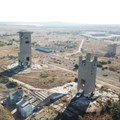Jet Demolition, Edifice Engineering collaborate on tallest building imploded in India

The successful implosion of the Apex and Cayenne towers (103m and 97m respectively) followed India’s Supreme Court ruling ordering the illegal structures to be demolished. “India is a vibrant democracy where all voices are heard and concerned citizens express their anxieties vigorously. They do not hesitate to embark on litigation to challenge big business when necessary to correct flouting of building regulations. More corrective actions are expected in future,” comments Jet Demolition director Joe Brinkmann.
The implosion of the towers follows on from the success of the two companies in their previous collaboration in January 2020, when three high-rise structures were imploded within 24 hours. “What makes Apex unique is that not only is it the tallest building ever to be imploded in India, but also one of the top 15 tallest buildings to be imploded globally,” reveals Brinkmann.

Close proximity to neighbouring buildings
The detailed planning and implosion preparation was especially challenging due to the close proximity of the towers to neighbouring buildings, in addition to their robust construction, able to withstand high-magnitude earthquakes. Test blasting revealed that unusually high explosive loading was required to reliably fail the shear walls. “These shear walls fell into the class of ‘highly unforgiving’ when it came to attempts at explosive-driven rupture,” explains Brinkmann.
Due to the 3,516kg of explosives required to successfully fell the structures, the impact and potential for structural damage to surrounding buildings was a significant concern. There was heightened anxiety among authorities and stakeholders that the adjacent building at a mere 9m away, beset with structural degradation, would be further weakened and collapse from implosion-induced vibration.
Dozens of columns were strengthened, beams were back-propped, and an array of crack gauges was installed to monitor prominent structural cracks – but no movement or crack growth was induced by the implosion. Nearby buildings were draped with geotextile curtains to minimise window breakage. “Minimal superficial impact, with a small number of windows cracked, and an 8 m section of brick boundary wall to contend with after the implosion, is an extremely satisfying result,” stresses Brinkmann.

Support from local community
After decreeing that the demolition proceed rapidly, the Supreme Court remained involved in the leadup to the implosion, receiving feedback from all stakeholders and providing updated instructions as the project progressed. At peak, over 400 persons prepared the building for implosion, many of whom had families and their own residences within close proximity to the Supertech Twin Towers.
“Despite being nervous about the implosion, we were welcomed and supported by the local community, who entrusted their homes and livelihoods to us,” says Brinkmann. Prior to implosion, the surrounding structures, housing over 5,000 residents, were temporarily evacuated with the support of a 650-person police presence.
As for cleanup operations, the intention is to recycle all materials resulting from the implosion. “Over 68,000 tonnes of concrete rubble are expected to be crushed and reused, with liberated rebar sent to foundries for recycling. A large portion of the project cost is being recovered from the sale of the rebar, indicative of exactly how strong these buildings were,” points out Brinkmann. Clean-up and recycling operations are being led by Edifice Engineering, with an anticipated completion date of December 2022.
Citing the project as one of the most challenging ever undertaken by Jet Demolition, Brinkmann concludes: “Edifice Engineering and India have joined the 100m implosion club under extremely demanding conditions.”



















